Mellouk A., Chebira A. (eds.) Machine Learning
Подождите немного. Документ загружается.

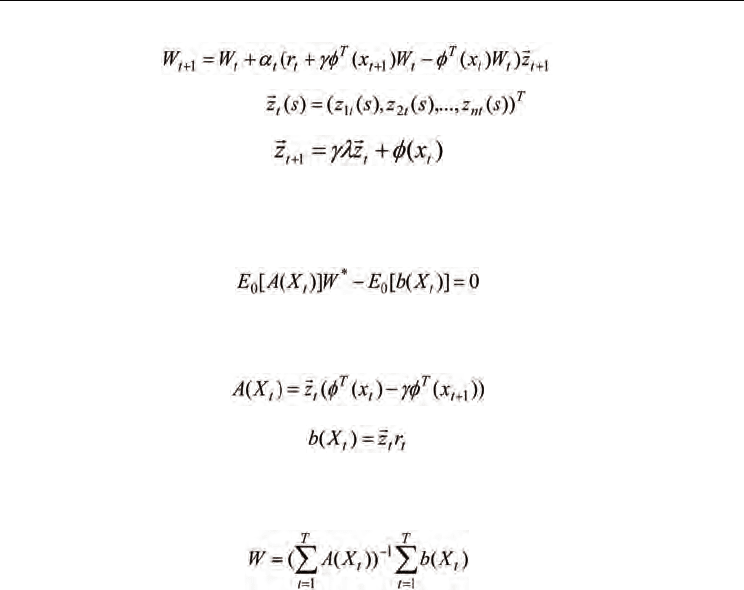
Machine Learning for Sequential Behavior Modeling and Prediction
413
(20)
where the eligibility trace vector
is defined as
(21)
In [19], the above linear TD( λ ) algorithm is proved to converge with probability 1 under
certain assumptions and the limit of convergence W* is also derived, which satisfies the
following equation
(22)
where X
t
=(x
t
,x
t+1
,z
t+1
) (t=1,2,…) form a Markov process, E
0
[· ] stands for the expectation with
respect to the unique invariant distribution of {X
t
}, and A(X
t
), b(X
t
) are defined as
(23)
(24)
Then, based on a set of observation data {(x
t
, r
t
)} (t=1,2,…,T), a least-squares solution to the
above problem can be obtained as [24]:
(25)
4.2 Kernel-based RL for sequential behavior learning
After introducing the above Markov reward model, the intrusion detection problem using
system call traces can be solved by a class of reinforcement learning algorithms called
temporal-difference (TD) learning. The aim of TD learning is to predict the state value
functions of a Markov reward process by updating the value function estimations based on
the differences between temporally successive predictions rather than using errors between
the real values and the predicted ones. And it has been verified that TD learning is more
efficient than supervised learning in multi-step prediction problems [22].
Until now, TD learning algorithms with linear function approximators have been widely
studied in the literature [23-24]. In [24], a linear TD learning algorithm was applied to host-
based intrusion detection using sequences of system calls and very promising results have
been obtained. Nevertheless, the approximation ability of linear function approximators is
limited and the performance of linear TD learning is greatly influenced by the selection of
linear basis functions. In the following, a sparse kernel-based LS-TD(λ) algorithm will be
presented for value function prediction in host-based IDSs [25]. The sparse kernel-based LS-
TD algorithm was recently developed in [26] and it was demonstrated that by realizing
least-squares TD learning in a kernel-induced high-dimensional feature space, nonlinear
value function estimation can be implicitly implemented by a linear form of computation
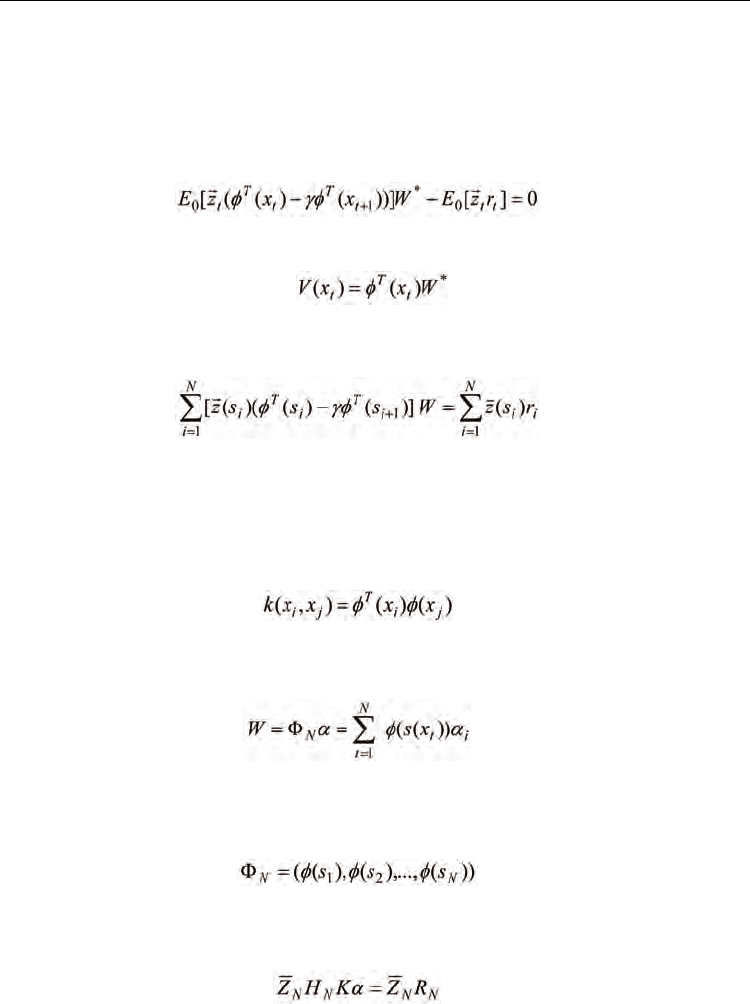
Machine Learning
414
with high approximation accuracy. Therefore, by making use of the kernel-based LS-TD
learning algorithm, the predictions of anomaly probabilities for intrusion detection will have
higher precision and it will be more beneficial to realize high-performance IDSs based on
dynamic behavior modeling.
In the kernel-based LS-TD learning method [26], the same solution to the following LS-TD
problem was considered:
(26)
where the corresponding value functions are estimated by
Using the average value of observations as the estimation of expectation E
0
[· ], equation (26)
can be expressed as follows:
(27)
Based on the idea of kernel methods, a high-dimensional nonlinear feature mapping can be
constructed by selecting a Mercer kernel function k(x
1
, x
2
) in a reproducing kernel Hilbert
space (RKHS). In the following, the nonlinear feature mapping based on the kernel function
k(.,.) is also denoted by
φ
(s) and according to the Mercer Theorem [27], the inner product of
two feature vectors is computed by
(28)
Due to the properties of RKHS [27], the weight vector W can be represented by the weighted
sum of the state feature vectors:
(29)
where x
i
(i = 1,2,..., N) are the observed states, N is the total number of states and
α = [
α
1
,
α
2
,...,
α
N
]
T
are the corresponding coefficients, and the matrix notation of the feature
vectors is denoted as
(30)
For a state sequence x
i
(i = 1, 2,..., N) , let the corresponding kernel matrix K be denoted as
K=(k
ij
)
N
×
N
, where k
ij
=k(x
i
, x
j
).
(31)
By substituting (28), (29) and (30) into (27), and multiplying the two sides of (27) with
T
N
Φ
we can get
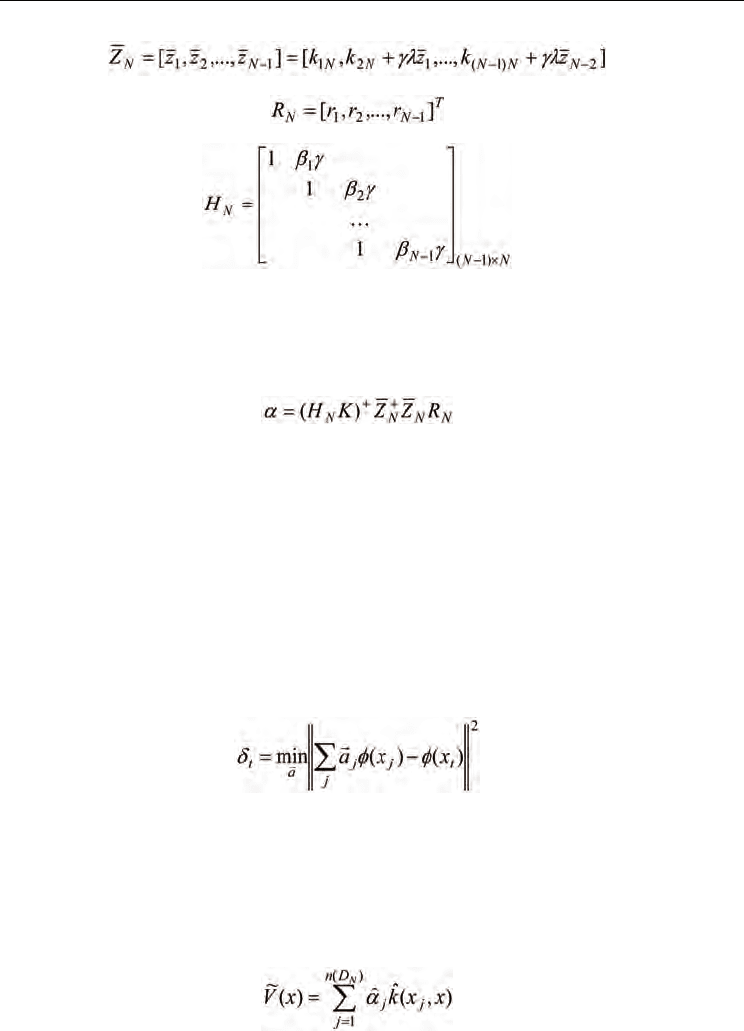
Machine Learning for Sequential Behavior Modeling and Prediction
415
(32)
(33)
(34)
In (34), the values of β
i
(i=1,2,…,N-1) are determined by the following rule: when state x
i-1
is
not an absorbing state, β
i
is equal to -1, otherwise, β
i
is set to zero.
As discussed in [26], by using the techniques of generalized inverse matrix in [28], the
kernel-based LS-TD solution to (26) is as follows:
(35)
where (.)
+
denotes the generalized inverse of a matrix.
One problem remained for the above kernel-based LS-TD learning algorithm is that the
dimension of the kernel-based LS-TD solution is equal to the number of state transition
samples, which will cause huge computational costs when the number of observation data is
large. To make the above algorithm be practical, one key problem is to decrease the
dimension of kernel matrix K as well as the dimensional of
α
. The problem has been studied
in [29] by employing an approximately linear dependence (ALD) analysis method [30] for
the sparsification of kernel matrix K.
The main idea of ALD-based sparcification is to represent the feature vectors of the original
data samples by an approximately linearly independent subset of feature vectors, which is
to compute the following optimization problem
(36)
During the sparsification procedure, a data dictionary is incrementally constructed and
every new data sample x
t
is tested by compute the solution δ
t
of (36). Only if δ
t
is greater than
a predefined threshold, the tested data sample x
t
will be added to the dictionary. For
detailed discussion of the sparsification process, please refer to [29] and [30]. After the
sparsification procedure, a data dictionary D
N
with reduced number of feature vectors will
be obtained and the approximated state value function can be represented as:
(37)
where n(D
N
) is the size of the dictionary.
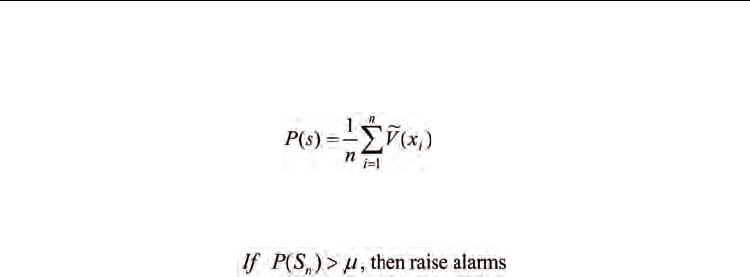
Machine Learning
416
When the above learning and sparcification process is completed, a value function model of
the IDS problem can be obtained. And the accumulated anomaly probability of a state
sequence S
n
={x
1
, x
2
,…x
n
} can be computed as
(38)
By selecting an appropriate threshold μ, the detection output of the adaptive IDS can be
simply determined as follows:
4.3 Performance evaluations
Generally speaking, previous works on machine learning methods for adaptive intrusion
detection can be mainly classified into four categories, i.e., supervised learning methods,
unsupervised learning methods, semi-supervised methods and statistical modeling
methods. Compared with the supervised learning methods in intrusion detection, the
proposed model does not require precise labeling of every observed feature, which is a
difficult task and may usually lead to the poor performance of supervised methods,
especially for complex sequential attacks. For unsupervised learning algorithms in intrusion
detection, e.g., SOM, clustering, due to the lack of prior information, the performance of
IDSs can not be optimized adequately [12].
The proposed RL-based dynamic behavior modeling approach for intrusion detection
estimates the anomaly probability of states based on the learning prediction of state value
functions. Therefore, it can be applied to detect complex attack behaviors with complex
sequential patterns. The computational complexity of TD learning algorithms is linear with
respect to the number k of state features and the length m of traces, i.e., it has time
complexity of O(km), which is lower than the training algorithm for HMMs, which runs in
time O(nm
2
), where n is the number of states in the HMM and m is the size of the trace.
Furthermore, since TD learning prediction methods using function approximators are
commonly used, the number k of state features can become much smaller than n and the
computational efficiency will be further improved.
For the RL-based approach, the most related methods are based on Markov chain modeling
or Hidden Markov models (HMMs), which are anomaly detection techniques that aim to
establish the probabilistic structure model of the normal data sequences explicitly. However,
the Markov reward model and the TD prediction method are based on hybrid modeling
strategy where the intrusion data can be combined with normal data to train the detection
model. Moreover, the RL-based method only implicitly constructs the probabilistic model
and the detection of anomalies is based on the estimated value functions. In [31], the
robustness of Markov chain modeling techniques was studied and it was shown that when
explicitly estimating the probabilistic structure of the Markov chain model for normal data,
the detection accuracy was very sensitive to the noise of data, i.e., when the intrusion data
were mixed with normal data, the performance of the Markov chain model would become
worse. Nevertheless, in our approach, the detection accuracy is not influenced by the mixing
of normal and abnormal data due to the hybrid modeling strategy.
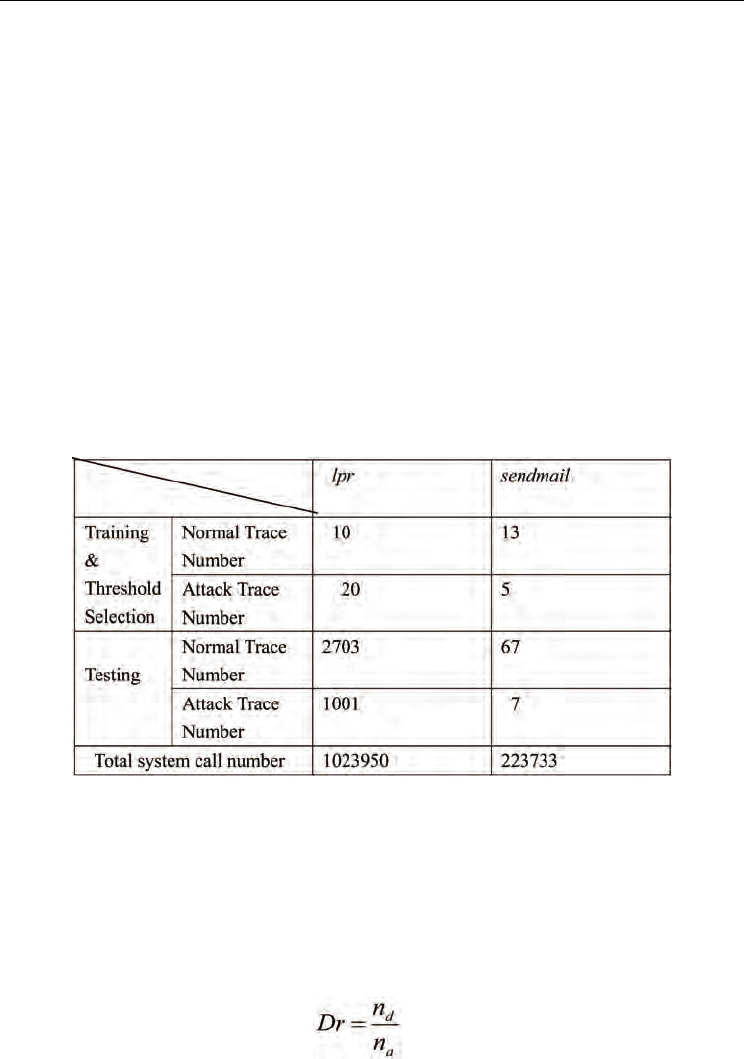
Machine Learning for Sequential Behavior Modeling and Prediction
417
To compare the performance between the previous HMM-based approach and the RL-based
approach, experiments on host-based intrusion detection using system calls were
conducted. In the experiments, two types of data sets were used, which include system call
traces from the “live” lpr and the Sendmail programs. Table 1 shows some of the details of
the data, which include two kinds of attack data and corresponding normal data. All of
these data sets are publicly available at the website of University of New Mexico [32].
In the data sets, each trace is a sequence of system calls generated by a single process from
the beginning of its execution to the end. Since the traces were generated by different
programs under different environments, the number of system calls per trace varies widely.
In the MIT environment, lpr was traced by running the program on 77 different hosts, each
running SunOS, for two weeks, to obtain traces of a total of 2766 print jobs. For detailed
discussion of the properties of the data sets, please refer to [32-33].
The two types of system call traces were divided into two parts. One part is for model
training and threshold determination and the other part is for performance evaluation.
Table 1 shows the numbers of normal and attack traces for training and testing. As can be
seen in the table, the numbers of testing traces are usually larger than those of testing
traces.
Table 1. Experimental data for host-based IDS
During the threshold determination process, the same data sets were used as the training
process, i.e., the training data sets and the data sets for threshold determination are the
same. For performance testing, the data sets are different from those in model training and
their sizes are usually larger than the training data. In the testing stage, two criterions for
performance evaluations were used, which are the detection rate Dr and the false alarm or
false positive rate Fp, and they are computed as follows:
(36)
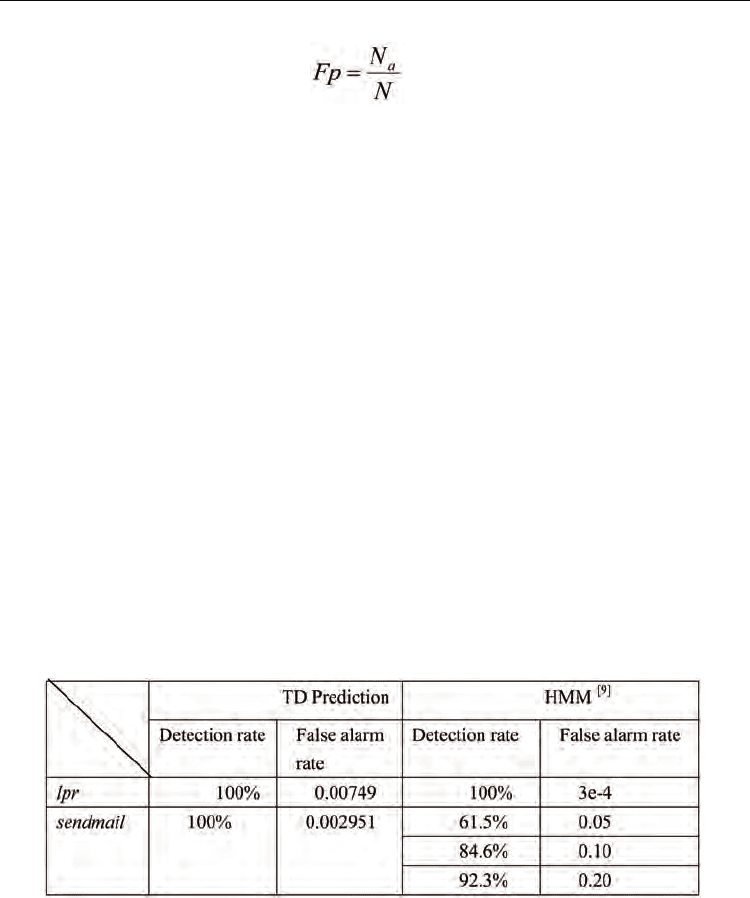
Machine Learning
418
(37)
where n
d
is the number of abnormal traces that have been correctly identified by the
detection model and n
a
is the total number of abnormal traces, N
a
is the number of normal
states that have been incorrectly identified as anomaly by the detection model, and N is the
total number of normal states. In the computation of false alarm rates, we use the same ideas
discussed in [4], where every possible false alarms during a long state traces are all counted
and the total sum of false alarms is divided by the number of all states in traces. Therefore,
the false positives were measured differently from the detection rates or true positives. To
detect an intrusion, it is only required that the anomaly probabilities exceed a preset
threshold at some point during the intrusion. However, making a single decision as to
whether a normal trace is abnormal or not is not sufficient, especially for very long traces.
For example, if a program runs for several days or more, each time that it is flagged as
anomalous must be counted separately. As pointed out in [17], the simplest way to measure
this is to count all the individual decisions. Then, the false-positive rate is selected as the
percentage of decisions in which normal data were detected as anomalous.
In the experiments, the TD learning prediction method was applied to the above data sets.
Every state in the Markov reward model has a system-call sequence length of 6, which has
been widely employed in previous works. The reward function is defined by (18). A linear
function approximator, which is a polynomial function of the observation states and has a
dimension of 24, was used as the value function approximator. To compare the performance
of TD learning prediction and previous approaches, the experimental results in [4], where
HMM-based dynamic behavior modeling methods were applied to the same data sets, are
also shown in the following Table 2.
Table 2. Performance comparisons between TD and HMM methods
To compare the performance between the kernel LS-TD approach with the linear LS-TD [16]
and the HMM-based approach [4], experiments on host-based intrusion detection using
system calls were conducted. In the experiments, the data set of system call traces generated
from the Sendmail program was used. The system call traces were divided into two parts.
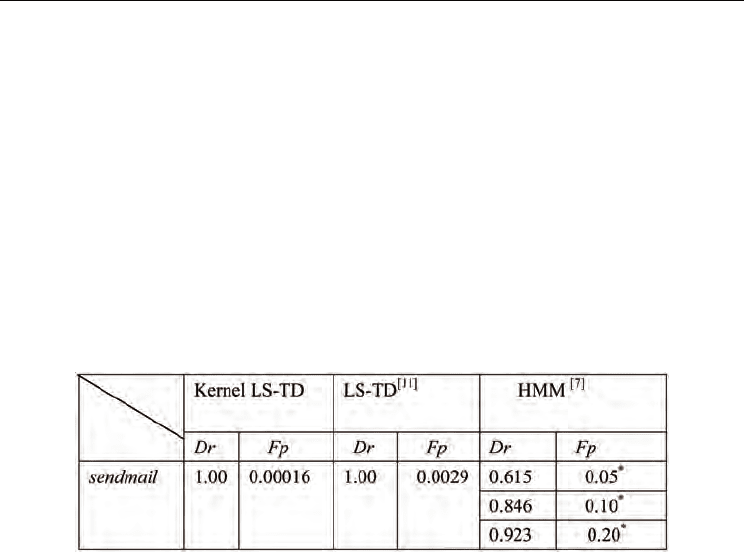
Machine Learning for Sequential Behavior Modeling and Prediction
419
One part is for model training and threshold determination and the other part is for
performance evaluation. The normal trace numbers for training and testing are 13 and 67,
respectively. The numbers of attack traces used for training and testing are 5 and 7. The total
number of system calls in the data set is 223733. During the threshold determination
process, the same traces were used as the training process. The testing data are different
from those in model training and their sizes are usually larger than the training data.
In the learning prediction experiments for intrusion detection, the kernel LS-TD algorithm
and previous linear TD(λ) algorithms, i.e., LS-TD(λ), are all implemented for the learning
prediction task. In the kernel-based LS-TD algorithm, a radius basis function (RBF) kernel is
selected and its width parameter is set to 0.8 in all the experiments. A threshold parameter
δ=0.001 is selected for the sparsification procedure of the kernel-based LS-TD learning
algorithm. The LS-TD(λ) algorithm uses a linear function approximator, which is a
polynomial function of the observation states and has a dimension of 24.
* The false alarm rates were only computed for trace numbers, not for single state
Table 3. Performance comparisons between different methods
The experimental results are shown in Table 3. It can be seen from the results that both of
the two RL methods, i.e., the kernel LS-TD and linear LS-TD, have 100% detection rates and
the kernel-based LS-TD approach has better performance in false alarm rates than the linear
LS-TD method. The main reason is due to the learning prediction accuracy of kernel-based
LS-TD for value function estimation. It is also illustrated that the two TD learning prediction
methods have much better performance than the previous HMM-based method. Therefore,
the applications of kernel-based reinforcement learning methods, which are based on the
Markov reward model, will be very promising to realize dynamic behavior modeling and
prediction for complex multi-stage attacks so that the performance of IDSs can be efficiently
optimized.
5. Conclusions
Although in recent years, there are many research works on applying machine learning
and statistical modeling methods to intrusion detection problems, the sequential
modeling problem in intelligent intrusion detection has not been well solved yet. In this
Chapter, the TD learning prediction method is introduced to construct detection models
and improve the performance of IDSs only by simplified labeling schemes using

Machine Learning
420
evaluative signals or feedbacks for sequential training data. It is illustrated that compared
with previous anomaly detection approaches using machine learning, the TD learning and
prediction method can obtain comparable or even better detection accuracies for complex
sequential attacks. More importantly, the proposed TD learning and prediction approach
provides an efficient anomaly detection technique with simplified labeling procedure and
reduced computational complexity. Future work may need to be focused on the extension
of the proposed method to more general intrusion detection systems with real-time
applications.
6. References
[1] D. Denning: An intrusion-detection model. IEEE Transactions on Software Engineering,
13(2) (1987) 222-232
[2] M. M. Sebring, E. Shellhouse, M. E. Hanna, and R. Alan Whitehurst. Expert systems in
intrusion detection: A case study. In Proceedings of the 11th National Computer
Security Conference, Baltimore, Maryland, October, (1988) 74-81
[3] W. K. Lee, Stolfo, S., and Mok, K.: Adaptive Intrusion Detection: A Data Mining
Approach. Artificial Intelligence Review, 14(6), (2000) 533 – 567
[4] D.Y. Yeung, Y.X. Ding, Host-based intrusion detection using dynamic and static
behavioral models. Pattern Recognition, 36 (2003) 229 – 243
[5] A. K. Ghosh and A. Schwartzbard. A study in using neural networks for anomaly
and misuse detection. in Proceedings of the 8th USENIX Security Symposium,
(1999).
[6] H.Shah, J.Undercoffer and A.Joshi: Fuzzy clustering for intrusion detection. In:
Proceedings of the 12th IEEE International Conference on Fuzzy Systems. (2003)
1274-1278
[7] D. Barbara, N. Wu, S. Jajodia, Detecting novel network intrusions using Bayes estimators,
First SIAM Conference on Data Mining, Chicago, IL, (2001).
[8] J. Ryan, M-J. Lin, R. Miikkulainen, Intrusion detection with neural networks, Proceedings
of AAAI-97 Workshop on AI Approaches to Fraud Detection and Risk Management, AAAI
Press, (1997) 72-77.
[9] X. Xu. Adaptive Intrusion Detection Based on Machine Learning: Feature Extraction,
Classifier Construction and Sequential Pattern Prediction. International Journal of
Web Services Practices, Vol.2, No.1-2 (2006), pp. 49-58
[10] M. Mahoney, P.Chan: Learning nonstationary models of normal network traffic for
detecting novel attacks. In: Proceedings of 8th International Conference on Knowledge
Discovery and Data Mining, (2002) 376-385
[11] X. Xu, X. N. Wang, Adaptive network intrusion detection method based on PCA and
support vector machines . Lecture Notes in Artificial Intelligence, ADMA 2005, LNAI
3584, (2005) 696 – 703.
[12] P. Laskov, P. Düssel, C. Schäfer, K. Rieck, Learning intrusion detection: supervised or
unsupervised? Proc. ICIAP 2005, September, Lecture Notes in Computer Science ,
LNCS 3617 (2005) 50-57

Machine Learning for Sequential Behavior Modeling and Prediction
421
[13] W.K. Lee, S.J.Stolfo: A data mining framework for building intrusion detection model.
In: Gong L., Reiter M.K. (eds.): Proceedings of the IEEE Symposium on Security and
Privacy. Oakland, CA: IEEE Computer Society Press (1999) 120~132
[14] http://www.kdnuggets.com/datasets/kddcup.html
[15] Y. H. Liao, V. Rao Vemuri, Using text categorization techniques for intrusion
detection, Proceedings of the 11th USENIX Security Symposium, August, (2002)
51-59.
[16] X.Xu, Intrusion Detection Based on Dynamic Behavior Modeling: Reinforcement
Learning versus Hidden Markov Models, International Journal of Computational
Intelligence Theory and Practice, 2(1), (2007) 57-66
[17] T. Lane, C. Brodley, Temporal sequence learning and data reduction for anomaly
detection. ACM Transactions on Information and System Security, 2(3) (1999) 295–331
[18] L. R. Rabiner. A tutorial on hidden Markov models and selected applications in speech
recognition. Proceedings of the IEEE, 77(2): 257-286, 1986.
[19] S. Hofmeyr et al., Intrusion detection using sequences of systems call, Journal of
Computer Security, 6 (1998) 151-180
[20] X.Xu, A Reinforcement Learning Approach for Host-Based Intrusion Detection Using
Sequences of System Calls. Lecture Notes in Computer Science, LNCS 3644, pp. 995 –
1003
[21] L. P. Kaelbling, M. L. Littman, and A. W. Moore. Reinforcement learning: a survey.
Journal of Artificial Intelligence Research, vol. 4, (1996) 237--285.
[22] R. Sutton, Learning to predict by the method of temporal differences. Machine Learning,
3(1), (1988) 9-44
[23] X. Xu, H. G. He, D. W. Hu: Efficient reinforcement learning using recursive least-
squares methods. Journal of Artificial Intelligence Research, vol.16, (2002) 259-292
[24] J. A. Boyan, Technical Update: Least-squares temporal difference learning. Machine
Learning, 49, (2002) 233-246
[25] X. Xu, Yirong Luo, A Kernel-Based Reinforcement Learning Approach to Dynamic
Behavior Modeling of Intrusion Detection, In : D. Liu et al. (Eds.): ISNN 2007,
Lecture Notes in Computer Science, LNCS 4491, Part I, (2007) 459–468
[26] X. Xu, et al., Kernel Least-Squares Temporal Difference Learning, International Journal of
Information Technology,11(9), (2005) 54-63
[27] Schölkopf, B., Smola, A.: Learning with Kernels. Cambridge, MA: MIT Press (2002)
[28] Nashed, M. Z., ed.: Generalized Inverses and Applications. Academic Press, New York,
(1976)
[29] Xu, X.: A Sparse Kernel-Based Least-Squares Temporal Difference Algorithm for
Reinforcement Learning. In: Proceedings of International Conference on
Intelligent Computing. 2006, Lecture Notes in Computer Science, LNCS 4221
(2006) 47-56
[30] Engel, Y., Mannor, S., Meir, R.: The Kernel Recursive Least-Squares Algorithm. IEEE
Transactions on Signal Processing, 52 (8) (2004) 2275-2285
[31] N. Ye, Y. Zhang, and C. M. Borror. Robustness of the Markov-Chain model for cyber-
attack detection. IE
EE Transactions on Reliability, 53(1), (2004) 116-123.
[32] http://www.cs.unm.edu/~immsec/data/

Machine Learning
422
[33] C. Warrender, S. Forrest, B. Pearlmutter. Detecting intrusions using system calls:
alternative data models. in the 1999 IEEE Symposium on Security and Privacy, May
9-12, (1999)
